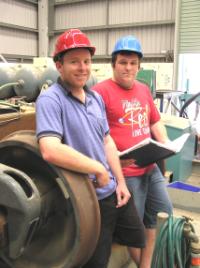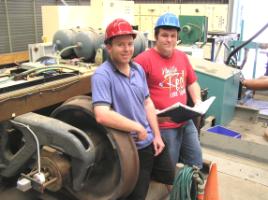Rocky duo keen on Italy - no railroading needed
Published on 22 October, 2008
Rockhampton rail researchers Mark Hayman and Chris Bosomworth did not hesitate when faced with the opportunity to work in a picturesque alpine region of Italy, near Turin, for CQUniversity-based company Rail Innovation Australia.
Mark and Chris have already spent 5 weeks enjoying the Italian summer, including sightseeing in Rome, a little excursion into the French alps and touring around the local villages. And they are heading off to Italy again in November and December, just in time to enjoy some weekend snow skiing.

Chris Bosomworth (left) and Mark Hayman
But it's not all play and no work. The pair are doing essential software engineering to support development of the new OZ-ECP brake technology, which is expected to increase Australian rail network capacity, increase safety, decrease stopping distances and provide a cheaper capital upgrade cost for rail operators than existing technologies on the international market.
Based at CQUniversity's Centre for Rail Engineering and working on the OZ-ECP brake project for Rail Innovation Australia, they have been working with project partner international brake supplier Faiveley Transport, which has its brake R & D division in Italy.
The first visit was to set up equipment, the next will be to undertake simulations and then it's back to Queensland for tests on the QR network in March 2009.
OZ-ECP was developed by the original Rail Cooperative Research Centre (CRC), and is now being commercialised by Rail Innovation Australia which commenced at the closedown of Rail CRC. The OZ-ECP brake technology has been developed by personnel at CQUniversity, Monash University and Queensland Rail, with additional support from other industry partners including Pacific National, RailCorp and Australian Rail Track Corporation.

The hills are alive for the Rocky pair While the OZ-ECP brake product, which incorporates an electronically controlled pneumatic brake retrofitted to existing conventional air brakes on a train wagon, is not expected to be ready for commercial operation until approximately 2010, QR and the Australian rail industry have already expressed their keen interest in the final product.


